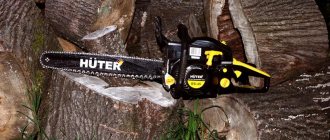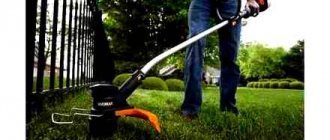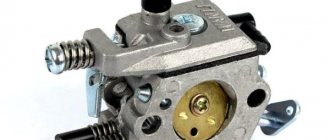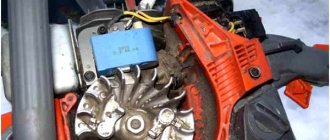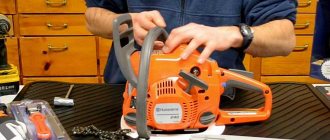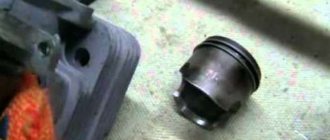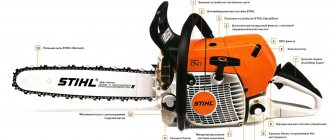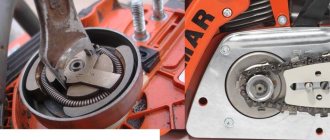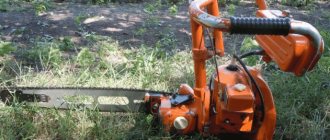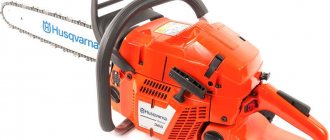How to replace primer correctly
Good afternoon, dear subscribers and guests of the channel!
The idea of writing an article on the topic of primer arose at the moment when a Husqvarna 240 came to me for repair. Remember the article - “I can do it myself” - how some owners repair chainsaws.
In this article I wrote how the owner of the saw independently changed the carburetor and at the same time the primer. When I inspected the chainsaw, I immediately noticed that the primer was not installed correctly and that is why I decided to tell you, maybe the information will be useful to someone.
How to install correctly
The design of the primer has two outlets for connecting hoses from a chainsaw. More precisely, one of them is the entrance, and the second is the exit. The input must be connected to the carburetor. Output to the return hose going to the tank.
The moment you press the primer, fuel is squeezed out of it into the tank, then the outlet valve closes and, due to the vacuum in the primer, the fuel is drawn through the inlet pipe into the carburetor.
As a rule, the outlet pipe is longer and the inlet pipe is shorter. It is better to start connecting from the inlet pipe, this makes it possible to check the functionality of the primer, at least that’s what I do.
Having connected the primer to the inlet pipe coming from the carburetor, you can press it several times until gasoline begins to flow from the outlet pipe. This is what indicates that the primer is installed correctly.
Fuel system
So that as the fuel mixture is used up, the fuel tank is filled with air and negative pressure is not created in it, which will prevent fuel from flowing from it into the carburetor, and at the same time, so that fuel does not flow out of the air hole, in the cap covering the filler hole, breather made. And by the way, if the breather becomes clogged with dirt, the chainsaw will stall.
Read:
Fuel is pumped from the tank through a hose that dangles freely in the tank. Thanks to this , regardless of the position of the chainsaw, the hose is always immersed in fuel. A fuel filter is attached to the inlet end of the hose. Fuel is pumped by a pump inside the carburetor.
To make starting easier, some chainsaws are equipped with a manual preparatory pump - a primer. When starting a chainsaw with a primer, the carburetor is filled with fuel in advance (excess fuel flows back into the tank). Thanks to this, the engine starts faster, because The stage of filling the carburetor with fuel has already been completed, which without a primer is carried out by the carburetor pump at the expense of the starter.
What happens if you swap the hoses?
If you swap the hoses, the fuel flow will go in the opposite direction, i.e. through the return hose, primer and only then into the carburetor. Moreover, the pump will press fuel into the carburetor under low pressure and as a result, gasoline will flow through the main fuel injector into the diffuser and then into the cylinder and air filter. And this will significantly complicate the launch of the tool.
Dear readers, repair your instruments correctly, do not forget to like and
subscribe to the channel so as not to miss the latest publications. See you soon!
Related Posts
In addition to the listed components, chainsaws have a system for cleaning the air supplied to the carburetor, a bar with a saw chain, a starter, a chain tensioning mechanism, an ignition, a muffler, etc.
Engine
The chainsaw engine has the highest speed of about 13,500 rpm. This imposes strict requirements on the oil added to the fuel mixture.
Clutch
At low speeds, elements with friction linings (1), having a degree of freedom in the circular direction, are attracted to the center of the shaft by springs (2) and do not transmit rotation to the drum (3), connected to the sprocket driving the chain. When the chainsaw engine speed reaches values at which the centrifugal force exceeds the force of the springs, the friction segments are pressed against the inner surface of the drum and begin to rotate it. As a result, the drive sprocket begins to rotate, driving the saw chain.
As you can see in the photo, the sprocket is located behind the clutch.
On other chainsaws, the sprocket may be located on the outside of the clutch.
The main advantage of this type of coupling is that when the chain jams, the chainsaw clutch slips without stopping the engine or causing damage to the devices that transmit movement from the motor to the chain.
Ignition system
The electric ignition of a chainsaw contains a flywheel (1) with built-in magnets, an ignition module (2) with an electrical circuit, a spark plug (3) and a high-voltage wire (4). A rotating flywheel with magnets induces an emf in the module, which is converted by an electrical circuit into electronic signals supplied to the spark plug. As a result, a spark jumps between the contacts of the latter, igniting the air-fuel mixture.
Carburetor
Below is a diagram of another chainsaw carburetor.
Carburetors have a throttle valve that allows you to lean or enrich the mixture, depending on the operating conditions. For the narrow option, there are a number of screws with which you can adjust low and high engine speeds, as well as idle speed. An air filter is installed on top of the carburetor to purify the air entering it.
Fuel system
So that as the fuel mixture is used up, the fuel tank is filled with air and negative pressure is not created in it, which will prevent fuel from flowing from it into the carburetor, and at the same time, so that fuel does not flow out of the air hole, in the cap covering the filler hole, breather made. And by the way, if the breather becomes clogged with dirt, the chainsaw will stall.
More information about each of the elements of the chainsaw
Diagram of a two-stroke engine with a double-diameter piston.
The most common chainsaws use a two-stroke engine with one cylinder. It works together with a flywheel, a special clutch, an ignition element and a bushing to secure the structure. Such an engine has a speed of about 13,000 rpm. In this regard, there are high requirements for the oil that is added to the fuel mixture.
The chainsaw is equipped with a centrifugal clutch, which is activated automatically depending on the number of engine revolutions. At low revolutions, elements with special linings that are free in the radial direction will be attracted to the central part of the shaft by springs and will not transmit rotation to the drum, which is connected to the sprocket from the chain. When the engine speed reaches values at which the centrifugal force exceeds the gain of the springs, the linings will press against the outer base of the drum and begin to rotate it. After this, the leading star will begin to scroll, which sets the chain in motion. The star is located behind the clutch or on the outside of the latter.
The main advantage of this type of clutch is that if the chain gets stuck, the clutch of the power tool will slip without stopping the engine or causing malfunctions in the devices that transmit movement from the engine to the chain.
More information about the ignition system and carburetor
Working process of a two-stroke engine.
Contact ignition, which was previously used in devices equipped with a gasoline engine, is no longer in demand. Designs from the best manufacturers are equipped with electronic ignition, which relieves users of the hard work of adjusting the gap in the contacts and their constant cleaning.
A modern ignition system consists of such elements as:
- flywheel;
- ignition system with electrical circuit;
- candle;
- high voltage drive.
The flywheel will rotate and initiate an electromotive force in the module, which will be converted by the electrical circuit into the necessary signals. Similar signals are then sent to the candle. A spark will appear between the contacts, which will ignite the working mixture.
A chainsaw carburetor is necessary to ensure smooth engine operation.
The carburetor is an important element of a gas powered tool. Together with the ignition, it will be able to ensure uninterrupted operation of the engine. With its help, you can prepare a fuel-air mixture, the quality of which will determine the ease of starting, power and uninterrupted operation of gas-powered tools. Most often, manufacturers of such saws use carburetors of the most common brands.
The carburetor has a valve that allows you to lean or enrich the mixture, depending on the operating conditions. To make fine adjustments, several screws should be used to adjust engine speed and idle speed. An air filter is installed at the top of the carburetor to clean the incoming air.
Chainsaw fuel system
In its simplest form, the fuel system consists of a tank with a volume of about 0.5 liters, a fuel filter and a hose through which fuel will be delivered to the carburetor. This tank volume is enough for approximately 35-40 minutes, considering that the power of the chainsaw is 2 kW and fuel consumption is no more than 1.2 l/hour. This flow rate will be obtained at the maximum load on the structure.
Chainsaw fuel system: 1 - fuel filter, 2 - carburetor, 3 - manual pre-priming pump.
In order for the tank to be filled with air as fuel is consumed and negative pressure does not form in it, a breather is made in the cap that covers the hole. If this device becomes clogged with dirt, the power tool stalls. You should know that under pressure, fuel will not be able to enter the carburetor.
Fuel will be pumped out of the tank through a hose that dangles freely in the tank. Its free movement is ensured so that the hose is always in the tank. A filter is attached to the input element. The fuel will be pumped by a pump structure inside the carburetor.
To make starting easier, some chainsaw designs are equipped with mechanical premature pumps - primers. If you start a gas-powered tool with a primer, the carburetor will first be filled with fuel, and the excess fuel will flow back into the tank. As a result, the engine will start faster because the carburetor will be filled with fuel. If there is no primer, the carburetor will be filled with fuel using the starter.
Air purification system
Chainsaw air purification system.
During operation, the engine of a gas powered tool uses the working mixture that is formed in the carburetor. To avoid dirty air entering the structure, it should be cleaned using filters. Such filters can consist of several elements. A snow filter will prevent snow from entering the air purification system; it is used only in winter. At high temperatures, the structure should be dismantled.
In some cases, air purification is carried out using centrifugal forces. The air flow is swirled by the flywheel impeller, after which impurities are thrown away from the inlet pipe, which leads to the installed filter. Filters of this type can be made of special foam rubber, nylon mesh and other materials.
During operation of a gas powered tool, the air in its operating area may become contaminated with sawdust. Too much contamination of the filtration device can reduce the amount of air that enters the carburetor. This can lead to a richer mixture and a decrease in the power of the power tool. This is why the filter needs to be constantly cleaned. Cleaning should be done not only when the instrument is disassembled for repair, but much more often. After each long-term work, it is recommended to clean the structure. The cleaning method will depend on the filter material: in most cases, blowing or washing is used.
Tool starter
Chainsaw starter device.
A similar element is used to launch the structure by turning the shaft. The mixture that is supplied to the engine will be compressed between the piston and the cylinder head. This mixture ignites when a spark occurs, causing the engine to turn on.
The starter consists of the following parts:
If you sharply pull the handle up, the drum ratchet will engage with the teeth that are located on the shaft. After this, the crankshaft will rotate. If the handle is released, the return spring will return it to its original position.
It will take some effort to turn the shaft at the speed at which the engine will start. In almost all cases, the gas-powered tool cannot be started the first time, so you will have to pull the handle many times. To make starting easier, you can use various methods. For example, you can enrich the fuel mixture using a special valve or reduce the pressure in the cylinder using a special valve. The valve can be made to automatically close in the event of an increase in pressure in the cylinder, which occurs during the combustion of the fuel. The design of the starter may contain a spare spring, which, if the cable is pulled, will first compress, and then sharply release, spinning the engine.
Read also: Bustilat what is it
Petrol tool chain
Saw chain structure.
The chain consists of cutting links, shanks and fixing elements. All components are assembled into a single structure using rivets.
The main and most complex links in the chain are cutting devices, which can be divided into right-handed and left-handed. The upper part of the clove is the widest. It is capable of providing a wide cut, which prevents other links from getting stuck.
The shape of the teeth for cutting can vary greatly between chains from different manufacturers. In most cases, chipper and chisel shapes can be seen, but there are other incisor shapes.
The edges of the cutting teeth are sharpened at a specific angle. If a rip saw chain is used, the angle will be 10°. If a cross-cut chain is used, the angle is 30°. It is worth noting that rip saw chains are used quite rarely. If necessary, longitudinal cuts can be made using a cross-cut chain.
Chainsaw chain pitch.
The main characteristic of the chain is its pitch. To set the chain pitch, you need to measure the gap between the central parts of the first and third fixing rivets. The result obtained should be divided by 2. This way you can get the chain pitch in mm. However, most often the pitch is indicated in inches. The gap between the central parts of such fastening rivets should be measured because the gaps between the holes of the links can have different sizes. The most commonly used chains are 0.325 and 3/8 inch pitches. The first chains are used in low power engines. High power chainsaws come with a 0.4 inch chain. If you use a chain with a small link thickness and a small pitch, you can get a clean and high-quality cut.
Important parameters include the thickness of the shank. The most commonly used chains are with a shank thickness of 1.3 mm. They are often used on both ordinary and specialized gas-powered tools. The thickness of the links must be coordinated with the gap width of the guide bar, and the sawing chain must exactly fit the guide bar.
Chain manufacturers use different production technologies and different materials. When choosing a material, you should not pay attention to hardness, since hard teeth are difficult to sharpen by hand. The main characteristics are toughness and impact strength, as they can be used to determine the durability of the structure. In the process of manufacturing cutting teeth, wear-resistant alloy steel is most often used. Quite often, cutters are chrome-plated to make it possible to increase the surface hardness. Some manufacturers use shot peening to increase the toughness of the teeth.
Petrol tool tires
Basic parameters of a chainsaw tire.
The bar is an important design of the chainsaw. It is used as a guide for the chain. During operation, the tire will be subject to significant loads, so it should be made of good quality viscous metal that has high elasticity.
To guide the chain, the tire must have a guide gap along the holes in which the chain links will move. The groove gap will also serve as a channel that supplies oil for processing the chain. The main parameters of the tire include:
- The dimensions of the fixed holes, which will depend on the type of gas-powered tool.
- The width of the gap, which corresponds to the thickness of the chain shank. The tire gap width is 0.02-0.05 mm greater than the thickness of the chain links. In this way, precise lateral guidance of the chain can be achieved.
- Star pitch, which determines the compatibility of the chains and tire used.
- The length of the cut, which determines the dimensions of the material being processed.
Chainsaw chain brake
The design of a chainsaw with an inertial chain brake.
The features of the chainsaw include an open cutting element in the form of a tire with a chain that runs along it. Such a tire can pose a considerable danger to the working element. Therefore, the design of a gas-powered tool must provide appropriate safety measures. The chain brake is designed to quickly stop the chain in the event of a kickback, which occasionally occurs when the spinning chain is accidentally touched. As a result, the tire may receive a sharp impact that will throw it to the side or upward. In this case, it will injure the user with the spinning chain. To avoid this, such a tool must be equipped with a brake structure that stops the rotation of the chain in the event of a kickback.
The launch of the braking element can be contact or inertial. The first will occur when the brake stop is pressed, which can occur during the process of throwing the tool back. In this case, displacement of the stop may lead to tightening of the brake band, causing the operating chain to stop.
The inertial start of the braking element is based on the inertial forces that arise in the event of a sharp impact on the tire, which act on the elements of the braking system. Ultimately, the same result will be obtained as in the previous case, tightening the tape and stopping the working chain. The inertial start of the braking element will occur faster than the contact one.
Preparatory work and assembly of gas-powered tools after repair must be completed by checking the chain brake system. If the brake element does not work, the saw is faulty.
Chainsaw chain lubrication system
Scheme for checking the operation of the chain lubrication system.
Lubrication of the chain and bar in gas-powered tools is carried out automatically. The oil will be poured into an appropriate container, after which it will flow through a special design into the pumping device, which is installed on the side of the working chain. From the pump structure, oil will flow into the tire gap, and then transfer to the chain itself.
The oil pumping devices are driven by a gear train which is driven by the drive sprocket. While the engine is idling, no oil will be supplied to the system. The performance of the pump structure will depend on the number of revolutions of the working star. The higher the speed, the more oil will flow to the chain. Some designs are equipped with a manual performance adjustment system.
A chainsaw is a complex mechanism, so it is recommended that you familiarize yourself with its design before starting work.
What type of carburetor is used in modern chainsaws
All modern chainsaws use membrane-type carburetors. They were developed by German designers of the world's leading chainsaw manufacturer Stihl in the mid-50s of the last century and revolutionized the design of chainsaws.
Before this, float carburetors were used, which could only work when the chainsaw was in a vertical position or tilted no more than 45-50 degrees. New membrane devices made it possible to operate a chainsaw even in an upside-down position.
Diaphragm type carburetor from different angles.
Float carburetors
The operating principle of membrane and float carburetors is the same. The difference is that older carburetors used a float instead of a membrane. This is a sealed lightweight container made of copper alloy with a steel axis in the center. The lower part of the axle fits into a sleeve at the bottom of the chamber and serves to hold the float. The top one is made in the form of a needle.
The photo shows a disassembled float-type carburetor, Druzhba chainsaw, in the middle (in the form of a rocker arm made of two barrels) there is a float.
When the chamber is filled, the float floats up and the needle shuts off the fuel supply, as in the membrane version. But if a chainsaw with a float carburetor is placed on its side, the float will not be able to float up to the end and the needle will not shut off the fuel supply. The carburetor will begin to “overflow”, as a result the engine will stop working normally. It is possible for the spark plug to flood, when the spark disappears and the engine stalls completely.
On the old Druzhba and Ural chainsaws, this lack of float carburetors was compensated for by the design features of the chainsaw itself.
Unlike modern chainsaws, the position of the cutting headset was adjustable in older models. The engine itself could remain in a stable position, vertically (plug at the top), and the bar and chain could be turned horizontally to fell a tree or vertically to saw a lying trunk.
We recommend reading a more detailed analysis of the design of float carbs in our article about Druzhba chainsaw carburetors.
The design and operating principle of a float carburetor is discussed in more detail in our article about the Druzhba 4 chainsaw carburetor.
However, the working position of a chainsaw with a float carburetor is always limited, which reduces the possibilities when working. A chainsaw with a diaphragm carburetor can work in any position, even upside down, which is important when sawing branches at height and working in hard-to-reach places.
The reliability of both options depends on the quality of the materials and workmanship used. The membrane must be made of plastic that is resistant to gasoline and retains its elasticity for a long time.
The floats failed due to loss of tightness and oxides in the channel when the needle began to get stuck in it.
The diaphragm carburetor is best suited for chainsaws. The operating principle itself has remained unchanged for more than half a century, but the quality of these devices is constantly improving. They become lighter, more compact, and form a better fuel mixture. As a result, internal combustion engines of chainsaws with modern carburetors consume less fuel and emit less harmful exhaust gases into the atmosphere.
Chainsaw and two-stroke engine devices
By design, all models of modern chainsaws are a mechanism driven by an internal combustion engine. Usually this is a single-cylinder two-stroke version, which does not have a classic gearbox. Its function is performed by a single-stage chain transmission, which drives the saw set. The main components of the chainsaw design:
- membrane type carburetor;
- ignition;
- fuel system;
- starter;
- air purification unit;
- chain and bar;
- chain brake (contact and inertial);
- tension mechanism;
- Lubrication system.
Figure 1 - External structure of a chainsaw
Chainsaws are equipped with a centrifugal clutch, which is activated automatically depending on engine speed. With sufficient power, special elements are pressed against the inside of the drum, setting the drive sprocket in motion. The advantage of such a mechanism is that when the saw jams in a cut, the clutch begins to slip, reducing the risk of breakage of the internal mechanisms.
Important ! The internal combustion engine in chainsaws has a maximum speed of up to 13.5 thousand per minute. The quality of its work directly depends on the fuel mixture and oil.
How to start a chainsaw?
In most European models, the starting system and starter have a similar device and operating mechanism. The exception is old domestically produced chainsaws (Ural, Lesnik). There is a handle on the body through which the cable is passed. If you lift it, the cable engages with the ratchet drum, and several revolutions of the crankshaft occur. At the same time, fuel is released and ignited with the help of a spark plug, after which the chainsaw starts up. To simplify the start, the following mechanisms can be implemented in high-quality chainsaw models:
- installing a damper in the carburetor to pre-enrich the fuel mixture;
- decompression valve, which reduces the operating pressure in the engine cylinder;
- a spring that simplifies the unwinding of the crankshaft while the cable is moving;
- additional pump for pumping fuel (usually found in American manufacturers).
The starter is constantly subjected to dynamic load. Because of this, it can fail at any time right during startup. If the saw is used frequently, it is recommended to carry out preventive maintenance at least once a year. It is recommended that only two people replace the cord in the starter, as it is necessary to securely fix the spring.
How to properly start (start) a cold chainsaw with and without a primer?
Chainsaws with a primer, which is a transparent rubber bubble, by definition start up faster and easier than chainsaws without that same primer.
But I will say this - professional devices often do not have them, and professional sawers consider this detail superfluous in the design of a chainsaw.
Starting a chainsaw with a primer is done by first pumping it in several clicks, but if it is not there, the chainsaw starts without this procedure.
Starting a cold chainsaw is done as follows:
Turn on the ignition, close the air damper, pull the starter with several vigorous (not sharp!) movements until the first flash appears, open the air damper and start the chainsaw, let it run for a few minutes to warm up - then start working.
Besides the fact that the primer very debatably helps in starting a chainsaw, for me it’s generally whether it’s there or not, I didn’t feel any difference in relief, and also this rubber band can simply leak at the most inopportune moment and you won’t be able to use the chainsaw anymore, so always with You need to carry this small condom with you for the primer, otherwise when you come to the dacha to cut some wood, you can just use gasoline for the trip back and back to the store for this small rubber band, this is what a primer is.
www.remotvet.ru
How to turn on a chainsaw?
After preparing the tool for sawing and filling the fuel tank, you can proceed directly to start-up. It should be remembered that after purchasing a chainsaw, a run-in is required - starting at idle, cutting wood (up to 10 cm in diameter) at medium speed. Foreign models reach full power after 5-7 tanks have been used up; old domestic saws are run in at partial load for 24 hours (3-4 full refills). During this period, it is strictly forbidden to heat the engine, allow prolonged idling, or apply maximum loads when sawing.
Launch stages
After all checks, you can run the tool for further work. To do this, the saw must be placed on a stable surface so that the bar does not touch the ground. Step-by-step algorithm:
- Disengage the chain brake using the handle on the body of the chainsaw.
- Turn on the ignition by pressing the button or switch (usually the leftmost position).
- Move the air supply damper to the closed position. Pull out the throttle lever and lock it in an intermediate position.
- Take the front handle with your left hand and press it lightly to the bottom. Step on the protective shield of the right handle with your foot.
- With your other free hand, you plan to pull the starter handle towards you until the pawls in the ratchet mechanism engage the drum clutch. Make a sharp jerk.
- After the first flash in the ignition chamber, turn the air damper to its original position. Start the saw again.
Once the engine starts, give full throttle and release the throttle lever completely. Normally, the trigger unit should automatically turn off.
Important ! The starting position of the saw depends on the specific model as well as your dominant hand. Compact versions of this tool can be launched on weight.
Features of starting with a cold and hot engine
In order for the engine to start, several processes occur simultaneously in the device. The supply of the fuel mixture to the engine piston begins, it is compressed and ignited by a spark from the spark plug. At the same time, the quality of the air mixture differs when starting with a cold and hot internal combustion engine.
If in a heated state a normal level of air is sufficient, then in a cold state there is not enough of it. In such a situation, it is necessary to pull the starter many times, which leads to wear on its cable. To regulate the supply of air mass in the carburetor there is a special damper. In cold weather, it must be opened completely, if necessary, pump fuel directly into the carburetor using a primer. This will speed up the startup of the chainsaw and reduce the risk of damage to its main components.
How to hold the instrument?
There are several methods for holding a chainsaw to start. The simplest option is to place the tool on a flat surface, grab the upper handle with your left hand, holding the guard with your foot. The second way is to hold the top handle of the saw with your hand and secure the back part between your legs. This position is only suitable for low-power and compact models of household chainsaws.
Figure 4 - How to hold a chainsaw
Checking the oil supply
To achieve the sliding of the chain along the headset, there is a special oil tank in the engine crankcase - it supplies oil to the tire. Its operation is controlled by a special pump, which starts when the engine speed increases. To check the flow and operation of the lubrication process, you need to remove the side protection of the tire and start the tool. If the oil enters the headset and decreases in the tank (check with a dipstick), then no action is required. If the amount of mixture is insufficient, it is recommended to clean or replace the filter, and then adjust the flow.
Distinctive features of winding of different brands
Some models may have a slightly different starting system. The main difference is in the location of the main elements on the body (the presence or absence of a primer, the number of bolts for tensioning the chain, etc.), as well as in the proportion of preparation of the fuel mixture. After purchasing the tool, you should carefully read the instructions, which always indicate the algorithm for the first start-up, running-in and frequency of preventive measures.
Important ! The design elements of Chinese chainsaws are especially often different. When choosing such a tool, you should check in advance for detailed instructions.
Features of launching in winter
Before starting work in winter, it is recommended to first bring the chainsaw into a warm room for 10-15 minutes. If this is not possible, start the tool at idle speed, moving the air damper to the middle position. Increase engine power only after pre-warming. Some models have the ability to switch air intake in summer and winter mode - this is the optimal solution if you often work in the forest at any time of the year.
Is it possible to start without a starter?
It is impossible to start a chainsaw without a starter. In the absence of this element, disturbances will occur in the engine cooling process, since it contains the so-called “snail” that regulates the flow of cold air from the flywheel impeller to the internal combustion engine cylinder.
Video: How Chainsaw Primer Works
Using a damper, you can enrich or deplete the fuel with air, i.e. Adjust the intensity of its administration in accordance with operating conditions. Use the screws to adjust the motor speed. Gasoline flow in the diffuser from the chamber is regulated by a jet. The incoming air is cleaned by a filter installed above the carburetor.
Clutch mechanism
The chainsaw clutch is centrifugal type. It starts automatically when the engine speed reaches the required speed.
The operation of the centrifugal clutch is shown schematically in the photograph below, where the numbers correspond to the following structural elements:
- Friction pads;
- Springs;
- Drum.
At low engine speeds, the pads, which can move radially, are spring-loaded onto the shaft. At this time, they do not rotate the drum connected to the sprocket chain. When the internal combustion engine reaches a speed at which the force from the springs becomes less than the effective centrifugal force, the friction shoes move the drum in motion, pressing against its inner surface. In this case, the sprocket that moves the chain rotates. It can be located on different models of gasoline saws in front of or behind the clutch.
Fuel system
The structure of the fuel system is shown in the diagram below.
The numbers correspond to the following elements:
- Fuel filter;
- Carburetor;
- Manual fuel pump (primer).
Gasoline is in a tank from which it exits through the carburetor through a hose. The simplest options do not include a pump. The fuel filter is located at the end of a hose immersed in gasoline. Its appearance is shown in the following photo.
READ How much oil is in a chainsaw per 1 liter
When fuel is consumed, negative pressure is created in the tank due to its filling with atmospheric air. This leads to the fact that the supply of gasoline to the carburetor assembly is stopped. To avoid this phenomenon, close the tank equipped with a fan: When it is dirty, the tool is delayed.
A chainsaw primer makes it easier to start. The carburetor section is pre-filled with fuel, allowing the engine to start quickly and reduce engine load.
Air purification system
Clean gas is necessary to obtain a high-quality air-fuel mixture. The presence of impurities in the air can interfere with the operation of the internal combustion engine of the tool. Therefore, chainsaws are equipped to remove dirt using pre-filters and fine filters.
Pre-filtration is usually performed with a screed.
Designed for fine filters (photo below), they are made of nylon mesh or foam or materials with similar characteristics.
Some pollen models have an air purification system at the inlet. Centrifugal type. It is installed in place of the previous filter element. The meaning of this cleaning operation is that the incoming air flow is swirled by a flywheel. At the same time, pollutant particles are ejected from the nozzle leading to the filter.
Contamination of the filter elements reduces the amount of atmospheric air entering the carburetor unit. This leads to a drop in engine power to the saw. For this reason, filters that remove contaminants from the air must be cleaned regularly by washing or simply blowing them out. The appropriate method is determined by the material from which they are made.
Starting device
The chainsaw starter is designed to start the engine, which is carried out using the crankshaft. In this case, the air-fuel mixture in the engine is compressed by the piston. A spark ignites it, causing the internal combustion engine to start.
Starter components:
- Lever arm;
- Cable;
- Drum;
- Return spring.
When the handle with the cable is pulled sharply, the drum touches the shaft. The last one starts scrolling. By releasing the handle, the spring returns to its original position. To rotate the shaft at the speed at which the engine starts, some effort is required: in most cases, the handle will need to be pulled out several times.
To facilitate the engine starting process, in practice, for example, the following methods are used:
- Using a damper, the fuel mixture is enriched;
- Use a special valve to reduce the pressure inside the cylinder.
To make starting, some starter models also include an additional spring. It first contracts when the cable is pulled, and then opens, thereby rotating the motor.
Lubrication device
The guide, like the chain, is made of metal. When the tool is turned on, the chain begins to rotate at high speed. The result is friction and overheating of the material. This is why it is recommended to cool the chain during operation. If this is not done, it will wear out very quickly, and as a result the tire will also fail.
To prevent this from happening, all models and types of chainsaws (and electric ones too) have mechanisms that are responsible for lubricating the chain. Such devices perform several tasks simultaneously. First, they cool the chain material during operation. Secondly, they minimize the negative impact of chain friction on the guide bar.
The mechanism responsible for lubricating the chain on a chainsaw is an oil pump. You don't need to enable it separately. The work is done automatically. When the tool motor is turned on, oil begins to flow into the circuit. In this case, the frequency of oil supply depends on the rotation speed of the device. The pump itself is called a piston or plunger.
To understand the operating principle of an oil pump, it is necessary to study its main components in detail.
- Oil pump housing. Made from aluminum or plastic. The second option is most common in models intended for home use.
- Piston. Part necessary for pumping oil. It has a cylindrical shape driven by a worm gear.
- Air ducts Connect the oil and exhaust air ducts.
READ How to Sharpen a Band Saw on a Machine
Chainsaw oil pump
In general, the action of the piston looks something like this.
- On one side, the piston shaft is located next to the rod. On some models this can be adjusted. At the mine itself, the wall has a wavy shape.
- On the reverse side of the plunger there is its working part, which has a protrusion or cutout at the end of the structure.
- As the piston moves through the feed port, oil is drawn from the oil tank and then through the outlet port into the tire, which lubricates the circuit.
Chainsaw oil pump plunger
The basic circuit of the oil pump is extremely simple, and because of this, the cost of the chainsaw remains at a fairly low level. In addition, the part can almost always be repaired, with the exception of cases of wear of the corrugated wall. In this case, it is recommended to replace the device with a new one.
For some models, the oil supply design includes an oil pump design. Adjustment screw. If a part fails, do not work with the damaged tool. Checking the pump's performance is quite simple. Just place a blank piece of paper next to the tire, run the chainsaw and watch it a couple of times. If the mechanism is in working order, oil stains will appear on the paper.
Brake brake
The chain in a chainsaw is a traumatic factor. When it rotates, a short, light touch is enough to cause a cut or more serious injury. For this reason, the chainsaw has a chain brake that quickly stops it if this happens. Recoil.
There are two types of brakes depending on the mode of action:
- Inertial, reacting to the inertial force acting on the brake mechanism;
- Contact, stopping the chain during kickback after stopping the brake.
Always use a chainsaw to check the operation of the brake circuit for safety reasons. If it does not work, do not use the tool until the problem is resolved.
Chain tension device
The chain tensioner has a very simple design, regardless of the model of the tool. Consists only of a pin and an adjusting screw. The screw is tightened or unscrewed using a screwdriver or wrench. With its help, the pin moves in a special groove in the chainsaw. In this case, along with the movement of the pin, the chain stretches.
Some modern models have a keyless chain tensioner.
The location of the adjustment screw usually depends on the specific device model. It can be located on the side, bottom or behind the working unit.
If work is done with a loose chain, it may slip out of the grooves and injure a person using the chainsaw. However, this does not mean that you need to tighten the chain too much. If you tighten it too much, there is a good chance that it will work under full load, which could cause it to rupture. This could result in serious injury.
The general principle of operation of any model of chainsaw is simple: a running engine drives a chain used for sawing wood. The operation of the tool depends on the condition of its individual parts, the quality of the fuel mixture, and the degree of purification of the incoming air. To ensure that the equipment is used for as long as possible, regular maintenance must be arranged based on the instructions contained in the operating instructions.
Source
What to do if the chainsaw does not start?
There are many factors why a chainsaw will not start if the starting technology is followed. The most common causes and ways to eliminate them:
- there is no spark on the spark plug - replacement or drying is required if water gets in;
- problem with the supply of gasoline to the filter - blowing out the fuel hose or filter, replacing;
- If the fuel or air filter is clogged , proper cleaning is required.
If these simple tips do not help, you need a full diagnosis of the problems. It is recommended to take the chainsaw to a service center, where they can check the compression of the cylinder and crankcase, as well as the operation of the carburetor.
Proper starting of the chainsaw ensures stable and reliable operation of this tool. When starting, before starting sawing, you should properly prepare and fill the fuel mixture and adjust the main structural elements. It is important to take into account weather conditions, as well as the features of a particular model.
Design and operation of individual units
The individual chainsaw components discussed above, in turn, consist of different parts. To repair equipment yourself, you need to know the design and operation of the main systems.
Ignition system
First, the chainsaw ignition system is Contact Type. Now it is practically not used. Modern manufacturers equip their equipment with electronic ignition (photo below). For this reason, there is no need to regularly clean the contacts and set the required distance between them.
The ignition system, which produces a spark when the engine starts, consists of the following parts:
- Magneto;
- Candles;
- The electronic unit;
- Wiring;
- Engine on/off buttons.
The appearance of the elements of the ignition system of one of the Stihl chainsaw models is shown in the following photograph.
Magneto. This is an electrical alternator that supplies voltage to the spark plug. This can be of two types:
- Contact;
- Contactless.
Schematically, ignition systems with non-contact and contact types of magnets are presented below.
Any type of magnet includes the following parts:
- Flywheel;
- Permanent magnet;
- Coils consisting of core windings.
Part of the electronic unit Usually included are diodes, resistors of various sizes, thyristors, and capacitors. The connection diagram depends on the saw model.
READ How to Tension a Chain on a Champion Chainsaw
Ignition works according to the following principle:
- When the flywheel rotates with a permanent magnet attached to it, an electromotive force is induced in the system;
- The electronic unit converts the current generated in the circuit into electrical signals;
- They are transferred to the candle;
- A spark is formed between the contacts, which causes the air-fuel mixture to ignite.
Initially, the ignition is adjusted so that sparking occurs when the engine piston misses its top dead center by about 3-4 mm. If you focus on the circumference of the crankshaft, it corresponds to an angle of 28 degrees.
The candle consists of the following parts:
- Central and side electrodes;
- Housing;
- Insulator.
Thus, due to the presence of ignition, the fuel mixture is ignited, which ensures the transition of the engine to operating condition. The system must be adjusted periodically, which is easy to do yourself.
Carburetor
The carburetor is necessary for continuous operation of the engine. It consists of the following structural elements:
- Solid aluminum body;
- Injectors, which are valves that regulate the amount of fuel;
- Diffuser;
- Float chamber;
- Spray.
A valve is installed in the carburetor body, which regulates the supply of atmospheric air, a pulse channel, a diffuser, an inlet fitting, and two screws (idler and main). Very often, chainsaw manufacturers supply their products with carburetors of commonly sold brands.
Most models of chainsaws are equipped with the same (in design) carburetors. Their device is shown schematically in the photo below. Only rare modifications made in China may be distinguished by the absence of a number of parts in the carburetor.
To properly adjust the carburetor of a chainsaw, you need to understand the principle of its operation, namely:
- When the engine starts, an air damper located on the lower part of the housing opens;
- Due to the movement of the piston (stroke), a vacuum is created inside the float chamber, as well as in the air channel;
- This forces air to flow through the diffuser;
- From the fuel tank, the fuel mixture enters the float chamber, passing through the fittings;
- Then gasoline in a diffuser is mixed with atmospheric air and the resulting air-fuel mixture;
- It then enters the input channels;
- From there the mixture enters the combustion chamber.
